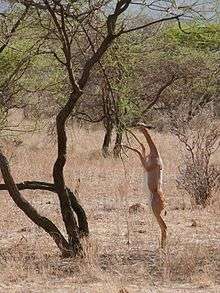Samburu National Reserve
| Samburu National Reserve | |
|---|---|
|
IUCN category II (national park) | |
|
Entrance | |
 Location of Samburu National Reserve | |
| Location | Kenya, Samburu County |
| Coordinates | 0°37′5″N 37°31′48″E / 0.61806°N 37.53000°ECoordinates: 0°37′5″N 37°31′48″E / 0.61806°N 37.53000°E |
| Area | 165 km2 (64 sq mi) |
| Established | 1985 |
The Samburu National Reserve is a game reserve on the banks of the Ewaso Ng'iro river in Kenya. On the other side of the river is the Buffalo Springs National Reserve. The park is 165 km² in size and is situated 350 kilometers from Nairobi. It ranges in altitude from 800 to 1230m above sea level.[1] Geographically, it is located in Samburu County.
In the middle of the reserve, the Ewaso Ng'iro flows through doum palm groves and thick riverine forests. It provides water, without which the game in this arid region could not survive.
The Samburu National Reserve was one of the two areas in which conservationists George Adamson and Joy Adamson raised Elsa the Lioness made famous in the best selling book and award winning movie Born Free.
The Samburu National Reserve is also the home of Kamunyak, a lioness famous for adopting oryx calves.
Habitat
Samburu National Reserve can be entered via the Ngare Mare and Buffalo Springs gates. Once inside the reserve, there are two mountains visible: Koitogor and Ololokwe. Samburu National Reserve is very peaceful and attracts animals because of the Ewaso Ng'iro river (meaning "brown water" and pronounced U-aa-so-Nyee-ro) that runs through it and the mixture of acacia, riverine forest, thorn trees and grassland vegetation. The Ewaso Ng'iro flows from the Kenyan highlands and empties into the famous Lorian Swamp. The natural serenity that is evident here is due to its distance from industry and the inaccessibility of the reserve for many years.
Wildlife

There is a wide variety of animal and bird life seen at Samburu National Reserve. Several large game species common to Kenya's northern plains can be found in abundance here, including the following dry-country fauna: gerenuk, Grevy's zebra, oryx and reticulated giraffe. All three big cats known as the Masai lion, Tanzanian cheetah and leopard can also be found here, as well as the elephant, Cape buffalo and Hippopotamus.[2]
Other mammals frequently seen in the park include olive baboon, warthogs, Grant's gazelle, Kirk's dik-dik, impala, and waterbuck. The rhinoceros population is no longer present in the park due to heavy poaching.
There are over 350 species of bird. These include grey-headed kingfisher, sunbirds, bee-eaters, Marabou stork, tawny eagle, Verreaux's eagle, bateleur, vulturine guineafowl, yellow-necked spurfowl, lilac-breasted roller, secretary bird, superb starling, northern red-billed hornbill, yellow-billed hornbill, and various vultures including the palm-nut vulture.
The Ewaso Ng'iro river contains large numbers of crocodile basks.[3]
Gallery
 Leopard in a tree at Samburu
Leopard in a tree at Samburu Gerenuk at Samburu
Gerenuk at Samburu Loxodonta africana at the edge of the Ewaso Ng'iro
Loxodonta africana at the edge of the Ewaso Ng'iro
 Lion male with scanty mane
Lion male with scanty mane- Large herd of Elephants crossing Ewaso Ng'iro river
See also
Properties and lodges
(listed alphabetically)[4]
References
- ↑ http://www.kenya.me.uk Facts about the Samburu National Reserve
- ↑ Jackman, Brian. "BBC - Big cat watching in Africa". www.bbc.co.uk. Archived from the original on August 4, 2007. Retrieved 2008-03-17.
- ↑ "Three lions fight crocodiles for food". stormmark.com. Retrieved 2014-08-21.
- ↑ Samburu National Reserve
External links
| Wikimedia Commons has media related to Samburu National Reserve. |
